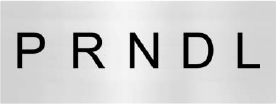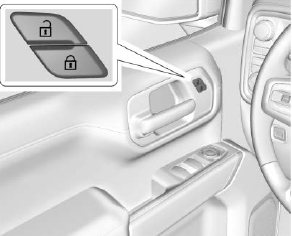Chevrolet Silverado: Automatic Transmission / Automatic Transmission
If equipped, there is an electronic shift lever position indicator within the instrument cluster. This display comes on when the ignition is in ACC/ACCESSORY, on or service mode.
There are several different positions for the shift lever.

See Driver Mode Control and “Range Selection Mode” under Manual Mode.
P : This position locks the rear wheels. Use P (Park) when starting the engine because the vehicle cannot move easily.
When parked on a hill, especially when the vehicle has a heavy load, you might notice an increase in the effort to shift out of P (Park). See “Torque Lock” under Shifting Into Park.
Warning
It is dangerous to get out of the vehicle if the shift lever is not fully in P (Park) with the parking brake firmly set. The vehicle can roll.
Do not leave the vehicle when the engine is running. If you have left the engine running, the vehicle can move suddenly. You or others could be injured. To be sure the vehicle will not move, even when you are on fairly level ground, always set the parking brake and move the shift lever to P (Park). See Shifting Into Park and Driving Characteristics and Towing Tips.
Warning
If equipped with four-wheel drive, the vehicle will be free to roll if the transfer case is in N (Neutral), even when the shift lever is in P (Park). You or someone else could be seriously injured. Be sure the transfer case is in a drive gear — 2 m, 4 m, or 4 n — or set the parking brake before placing the transfer case in N (Neutral). See Four-Wheel Drive.
R : Use this gear to back up.
Caution
Shifting to R (Reverse) while the vehicle is moving forward could damage the transmission. The repairs would not be covered by the vehicle warranty. Shift to R (Reverse) only after the vehicle is stopped.
To rock the vehicle back and forth to get out of snow, ice, or sand without damaging the transmission, see If the Vehicle Is Stuck.
N : In this position, the engine does not connect with the wheels. To restart the engine when the vehicle is already moving, use N (Neutral) only.
Also, use N (Neutral) when the vehicle is being towed.
Warning
Shifting into a drive gear while the engine is running at high speed is dangerous. Unless your foot is firmly on the brake pedal, the vehicle could move very rapidly. You could lose control and hit people or objects. Do not shift into a drive gear while the engine is running at high speed.
Caution
Shifting out of P (Park) or N (Neutral) with the engine running at high speed may damage the transmission. The repairs would not be covered by the vehicle warranty. Be sure the engine is not running at high speed when shifting the vehicle.
Caution
A transmission or engine oil hot message may display if the automatic transmission fluid or engine oil is too hot. Driving under this condition can damage the vehicle. Stop and idle the engine to cool the engine oil or automatic transmission fluid. These messages will clear when the engine oil or transmission fluid has cooled sufficiently.
D : This position is for normal driving. It provides the best fuel economy. If more power is needed for passing, press the accelerator pedal down.
- When going less than about 55 km/h (35 mph), push the accelerator pedal about halfway down.
- When going about 55 km/h (35 mph) or more, push the accelerator all the
way down.
By doing this, the vehicle shifts down to the next gear and has more power.
Use D (Drive) and Tow/Haul Mode when towing a trailer, carrying a heavy load, driving on steep hills, or driving off-road. Shift the transmission to a lower gear if the transmission shifts too often.
Downshifting the transmission in slippery road conditions could result in skidding. See “Skidding” under Loss of Control.
The vehicle has a shift stabilization feature that adjusts the transmission shifting to the current driving conditions in order to reduce rapid upshifts and downshifts. This shift stabilization feature is designed to determine, before making an upshift, if the engine is able to maintain vehicle speed by analyzing things such as vehicle speed, throttle position, and vehicle load. If the shift stabilization feature determines that a current vehicle speed cannot be maintained, the transmission does not upshift and instead holds the current gear. In some cases, this could appear to be a delayed shift, however the transmission is operating normally.
If the engine or transmission detects an impending hot fluid condition, the transmission may upshift to limit temperatures. Downshifts may also be prevented. Normal operation may continue unless the display indicates there is a hot condition and engine should be idled.
The transmission uses adaptive shift controls. The adaptive shift control process continually compares key shift parameters to pre-programmed ideal shifts stored in the transmission’s computer. The transmission constantly makes adjustments to improve vehicle performance according to how the vehicle is being used, such as with a heavy load or when the temperature changes. During this adaptive shift control process, shifting might feel different as the transmission determines the best settings.
When temperatures are very cold, the transmission's gear shifting could be delayed providing more stable shifts until the engine warms up. Shifts could be more noticeable with a cold transmission. This difference in shifting is normal.
If equipped with the 2.7L L4 engine, engine speeds may be increased while driving at highway speeds while the engine is still warming up.
L : This position allows selection of a range of gears appropriate for current driving conditions. If equipped, see “Range Selection Mode” under Manual Mode.
Caution
Spinning the tires or holding the vehicle in one place on a hill using only the accelerator pedal may damage the transmission. The repair will not be covered by the vehicle warranty. If the vehicle is stuck, do not spin the tires. When stopping on a hill, use the brakes to hold the vehicle in place.
 Manual Mode
Manual Mode
Range Selection Mode
Range Selection Mode helps control the vehicle's transmission and vehicle speed
while driving downhill or towing a trailer by letting you select a desired range
of gears...
Other information:
Chevrolet Silverado 2019-2026 Owners Manual: Buying New Tires
GM has developed and matched specific tires for the vehicle. The original equipment tires installed were designed to meet General Motors Tire Performance Criteria Specification (TPC Spec) system rating. When replacement tires are needed, GM strongly recommends buying tires with the same TPC Spec rating...
Chevrolet Silverado 2019-2026 Owners Manual: Driver Mode Control Light
..
Categories
- Manuals Home
- 4th Generation Silverado Owners Manual
- 4th Generation Silverado Service Manual
- Head-Up Display (HUD)
- Tire Chains
- Steering Column Lock
- New on site
- Most important about car
Power Door Locks

If equipped with power door locks.
 : Press to lock the doors.
: Press to lock the doors.

